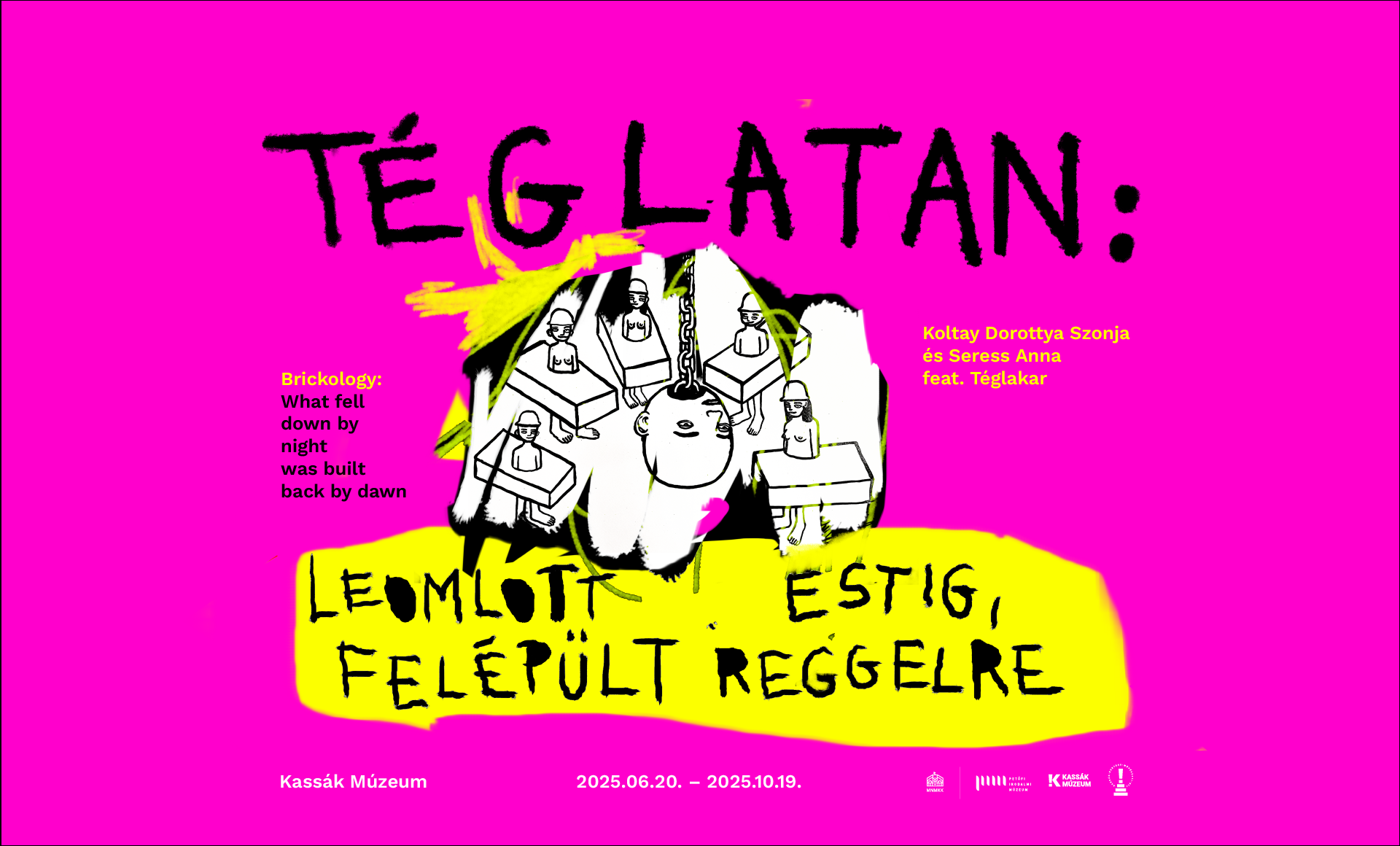BRICKOLOGY: WHAT FELL DOWN BY NIGHT, WAS BUILT BACK BY DAWN / Extended until November 9!
Dorottya Szonja Koltay and Anna Seress
Feat. the Brick Choir
Vernissage: 19 June 2025, 6 pm
The Bricks may be silent, but they are not mute. They are knowers of difficult stories. The Bricks are experienced wall-residents, and know the grief of the Stonemason’s wife. They also know her child, who grew tired of his mother's silent cries.They break the wall and its silence for them and with them. They arrange themselves in a demolition ensemble with elements known from construction sites, singing the song of wheelbarrows, accompanying the boom of the wrecking ball with the vocal of a plasterer's spoon. The Bricks work on getting the Stonemason’s wife out of the wall, with music and dance, to live in a place where there is no woman in the wall, and no castle is built with sacrifice and silence. With their tools, they loosen symbolic buildings, fixed structures, and with their clamour, they seek to dismantle the fortresses of our society.
In their work, the Bricks demolish, but they do not bury their audience. Their show is an exercise in claiming space, a semi-open form that offers and expects audience participation, but does not make it compulsory.
The prelude to Bricology: What fell down by Night, was built back by Dawn was a public installation and performance series entitled Breaking the Stonemason’s wife out of the Wall, which focused on a contemporary social-critical interpretation of the folk ballad The Stonemason’s Wife. This project gave birth to the metaphor of the Brick, referring to the relationship between society, the individual and power. It also initiated the formation of the Brick Choir, a loose, semi-open collective. In the Brick Choir, as in the exhibition spaces, practices of care are embedded in social relations, their mortar role is part of not only patriarchal relations but also, more broadly, the capitalist world order that organises them. The operational and artistic aim of the Brick Choir is also to seek the emancipation of the Bricks (the individuals and communities that make up society) from the walls of a hierarchical fortress subordinated to the logic of the capital. To highlight forces of connection and cohesion that are not based on oppression, surrendering and subordination.
The current exhibition serves as a new chapter in this thought process. Arranged in a living, moving, changing installation, Dorottya Szonja Koltay’s works make the exhibition space a stage, a playground, a diary of the creative process and a discursive space where the audience can take on both playing and creative positions. This change of perspective is brought to life during the exhibition through participatory interventions, a series of performances, collective singing and dancing. We hope to create an opportunity to reflect on the relationship between the individual and the community, its frameworks, and the dominant power relations, both within the context of the exhibition’s metaphorical system and outside of it. We also give space to imagine solidarity-based, mutually supportive and cohesive communities, which make the community of individuals, rather than the individual, their cornerstone. Where the aim is not to build another castle, where we do not seek alternative mortar, where we do not deny our brick-form, but where we are not just made of brick dust either.
Exhibiting artist: Dorottya Szonja Koltay
Curator and co-creator: Seress Anna Seress
Exhibition organization: Judit Csatlós, Merse Pál Szeredi
Music and sound design: Kurszán Koltay
Graphic design: Dorottya Szonja Koltay
Prepress: Gábor Bogdándy
Design assistant: Laura Létai
Installation: Ferenc Badak, Attila Batári, Gábor Bogdándy, Annamária H. Kocsis, Gyula Kemény, Judit Kodolányi, Alex Kovács, György Mihalkov, Ádám Skublics, Digitalprint & expo, Erzsike (kulcsmásoló és cipőjavító műhely), Gyuri Németh, Tufting világ
Communication: Renáta Szikra
Special Thanks: Csenge Bánkuti (Dr. Törmelék), Andrea Bilák, István Bukovics, László István Dunai, Sára Gálhidy (djeptégla), Zea Gyarmati (Mennikő’), József Iszlai, József Mélyi, Misel Gara, Anna Módos, Róbert Nunkovics, Iván Seress, Zoltán Seress, Zsófia Szász (Téglasztik), Máté Szemes, János Szén, Zsombor Telenkó, Sára Törley-Havas (Betonci(ca)/KetonBeverő), Eszter Vági (szögletke), Ildikó Végh (Akciós bontott tégla), Georg Winter
Brick Choir:
- Falazóelem: Dóra Botka
- Téglasztik: Zsófia Szász
- Akciós bontott tégla: Ildikó Végh
- Jó Zsalu/Habarcska: Erika Kovács
- Alapkő/Résecske: Edit Farkasinszky
- Dr. Törmelék: Csenge Bánkuti
- Szabotőr Fándli: Kriszta Nemes Papp
- Szabó T. Gla: Lilla Szauer
- Szögletke: Eszter Vági
- Mennikő’: Zea Gyarmati
- Éneklő Téglakő/Késő Véső: Anett Dublecz
- djeptégla: Sári Gálhidy
- Terra Kotta: Anita Ureczki
- Bukoósisak: Artúr Poór
- Reszkető Függőón: Márton Kovács
- Beépített Ember/ Malteregó: András Losonczy
- Malterov Malterovna: Anna Seress
- Bontógolyó: Dorottya Szonja Koltay
The exhibition was realised through the support of the 2024 Kassák Contemporary Art Award.
Opening times: 20 June to 19 October 2025

